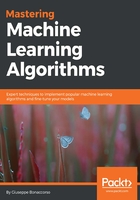
To get the most out of this book
There are no strict prerequisites for this book; however, it's important to have basic-intermediate Python knowledge with a specific focus on NumPy. Whenever necessary, I will provide instructions/references to install specific packages and exploit more advanced functionalities. As Python is based on a semantic indentation, the published version can contain incorrect newlines that raise exceptions when executing the code. For this reason, I invite all readers without deep knowledge of this language to refer to the original source code provided with the book.
All the examples are based on Python 3.5+. I suggest using the Anaconda distribution (https://www.anaconda.com/download/), which is probably the most complete and powerful one for scientific projects. The majority of the required packages are already built in and it's very easy to install the new ones (sometimes with optimized versions). However, any other Python distribution can be used. Moreover, I invite readers to test the examples using Jupyter (formerly known as IPython) notebooks so as to avoid rerunning the whole example when a change is made. If instead an IDE is preferred, I suggest PyCharm, which offers many built-in functionalities that are very helpful in data-oriented and scientific projects (such as the internal Matplotlib viewer).
A good mathematics background is necessary to fully understand the theoretical part. In particular, basic skills in probability theory, calculus, and linear algebra are required. However, I advise you not to give up when a concept seems too difficult. The reference sections contain many useful books, and the majority of concepts are explained quite well on Wikipedia too. When something unknown is encountered, I suggest reading the specific documentation before continuing. In many cases, it's not necessary to have complete knowledge and even an introductory paragraph can be enough to understand their rationale.